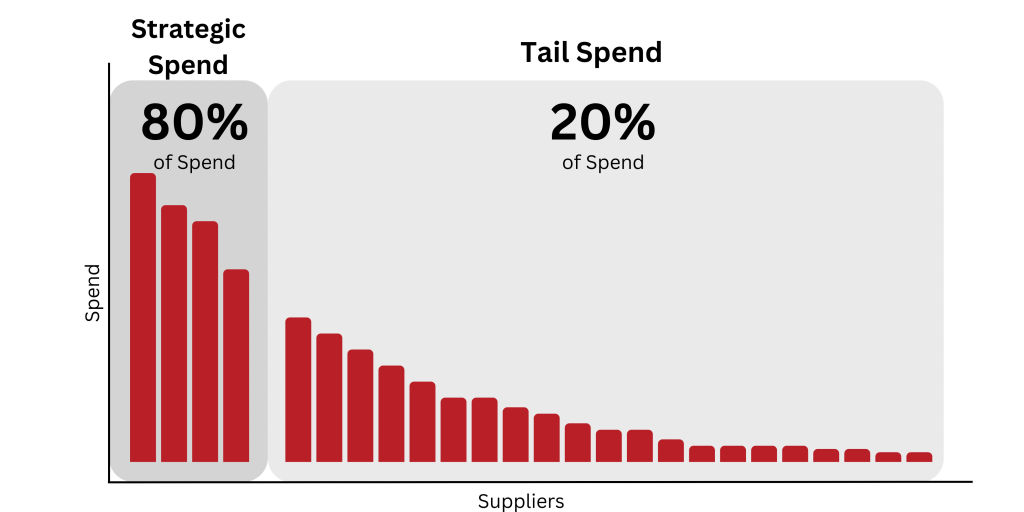
What is Tail Spend?
Many people often ask what is Tail Spend? Well, tail spend is a term in procurement referring to the spend which is spent on a large number of suppliers with a small part of the budget. Tail spend generally accounts for 80% of suppliers, but only 20% of spend. These ratios will differ depending on the business and industry, but tail spend will always account for the majority of suppliers and minority of spend.
The opposite of tail spend is Strategic spend, where businesses spend more of their budget on less of their suppliers. Strategic spend is heavily monitored and discussed, as these are key business decisions, whereas tail spend will usually have opportunities for improvement as it is monitored less, such as office supplies.
Businesses may find tail spend difficult to manage due to the large number of suppliers. Combine this with the relatively low cost per transaction and you will find why this is often overlooked. Due to being overlooked this will mean a large amount of money will be wasted over time.

The low cost per transaction and difficulty to manage mean it will often be seen as less of a priority than strategic spend. Resulting in unnecessary spending happening due to mismanaged tail spend, but this also offers an opportunity to control your tail spend and gain a competitive advantage.
If tail spend is not properly managed, then problems that may arise:
Overspending for Products: Just because the value of the item is small, does not mean that the cost should be ignored. As this will make up 80% of suppliers, this will quickly add up to a significant cost to the business if not monitored.
Wasted Time and Effort: By not having processes in place, time and effort can be wasted by teams sourcing products which could be better spent elsewhere.
Quality Issues: If proper research is not done, purchases may not meet strict quality assurance requirements. This would mean time is wasted re-ordering to adhere to quality standards and could negatively affect the business and their reputation.
Managing tail spend is important in order to reduce wasted spend, save time and resources for the company but how do you actually manage tail spend?
How to Manage Tail Spend?
There are many ways to manage tail spend, it can be recommended to use a combination of techniques to maximise effectiveness:
Tail Spend Analysis: The most important way to highlight potential issues is to undertake a tail spend analysis. Audit how and when you are spending, look closely at all spending under a certain monetary value which may otherwise be overlooked and analyze if there are potential savings here. Are additional hidden costs sneaking in? Such as having to order and re-order if the original order is not compliant.
Categorization and Classification: Categorize and classify all purchases to identify which fall into the tail spend category. Using a data-driven approach allows you to understand the specific areas and suppliers contributing to tail spend. With this information, you can set priorities for improvement, renegotiate contracts, and consolidate purchases to achieve better pricing and terms.
Outsource Procurement: Using procurement specialists to manage tail spend will shift the burden to the experts to mange suppliers and negotiate terms and prices. This will reduce suppliers in your internal systems and allow your business to focus on core activities. The Boston Consulting Group state “a company that focuses entirely on tail spend is probably able to optimize savings and has better economies of scale than others”.
Understanding and effectively managing tail spend is a key part of the procurement processes. Tail spend represents a significant opportunity for cost reduction, supplier consolidation, and process improvement. Understanding tail spend allows you to take control of your spending and turn it into a source of competitive advantage by removing excess costs.
With the right approach and the expertise of procurement specialists you can reduce costs, enhance supplier relationships, compliance, and overall operational efficiency.


